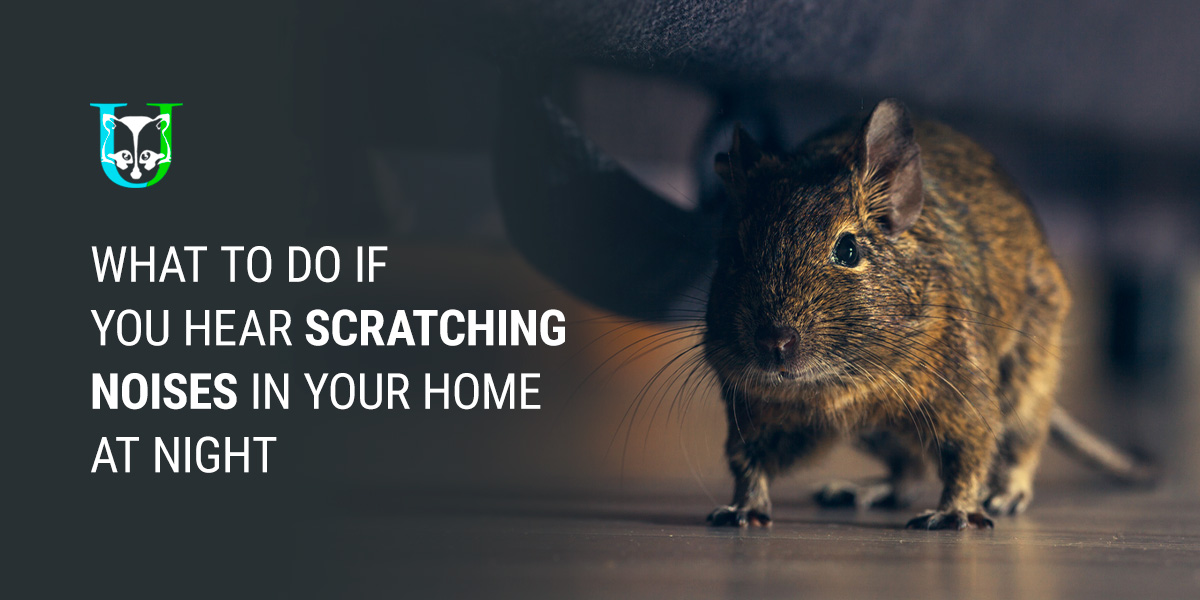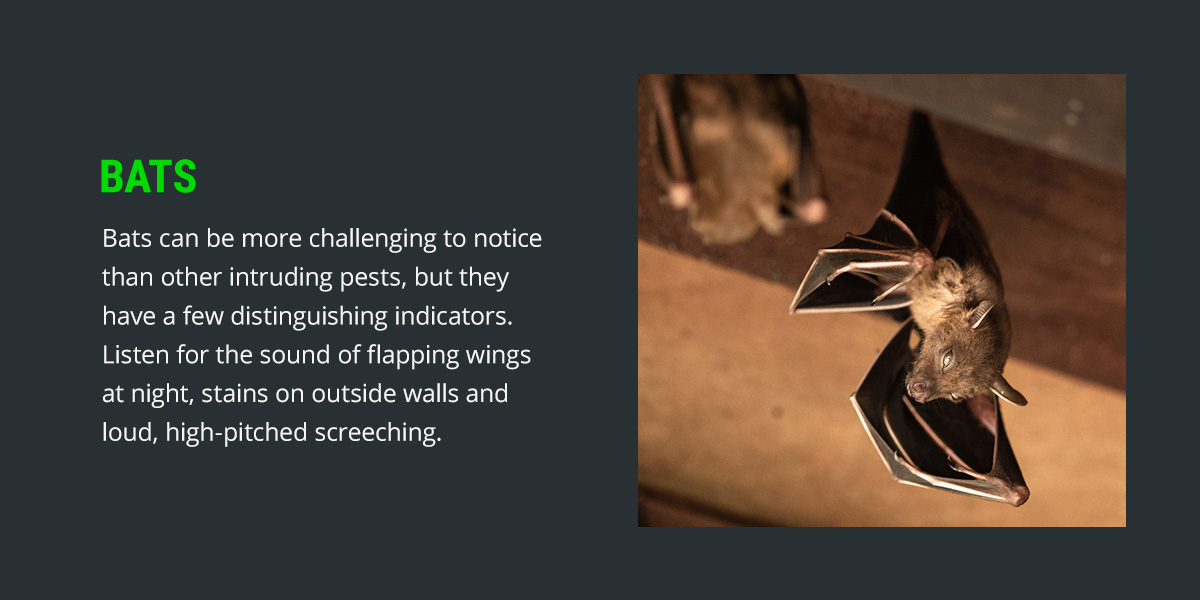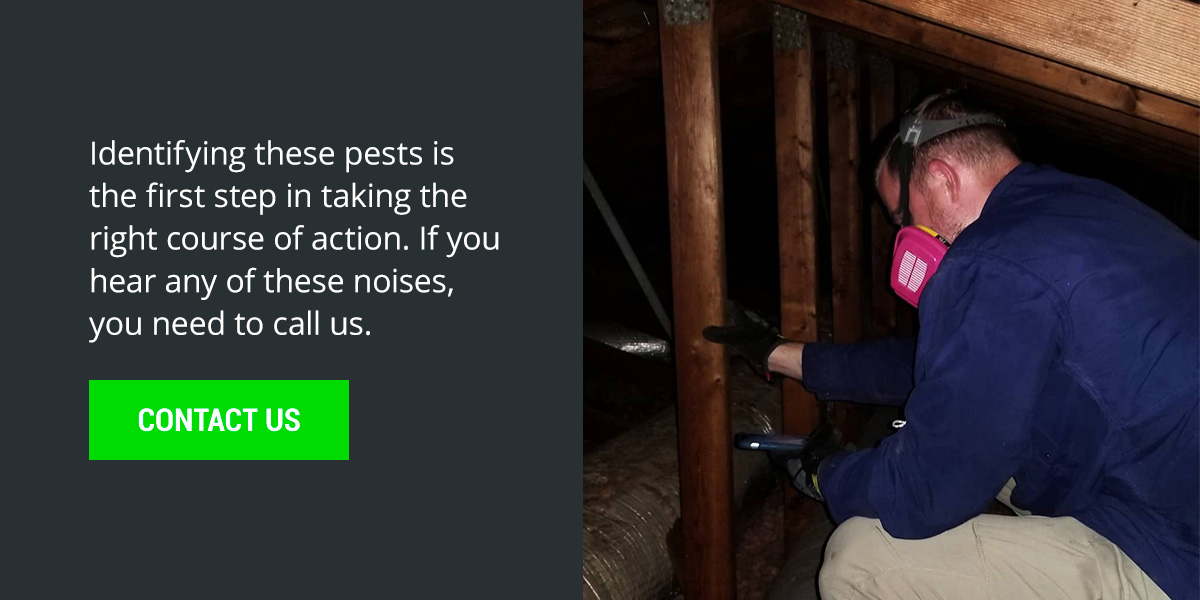
Your home is your sanctuary — a retreat from the world where you should feel safe and secure. Unfortunately, many other animals may feel the same way.
It can be scary to hear a scratching noise in your walls, ceiling, garage or attic at night. In these situations, your imagination can be your worst enemy, as you picture every possible intruder and wonder how much damage they might do. In many instances, animals will invade in search of warmth, shelter, nourishment and a place to raise their babies. This guide will teach you to identify which pests you hear at night and what actions you should take.
Why My Home?
Before we dive into this guide, we want to answer a frequently asked question — why are wild animals in my home? They are looking for food and shelter. In addition to be a safe dry place, many things about humans’ houses attract pests, including garbage cans, compost, pet food, food scraps, gutters, overgrown lawns, firewood, and gaps in your walls and roof. All these variables lure animals or allow them easy entry points.
How to Identify Nighttime Pests
Let’s help you calm your overactive imagination. Every nighttime pest you may encounter has specific identifiers that will help you determine what’s going on when you hear scratching in your walls and worry about things that go bump in the night. We will teach you how to identify the most common nighttime pests.
1. Rats and Mice
If you hear scratching in your walls at night, you might have rats or mice. Scurrying and pitter-patter noises are the telltale audible clues indicating rats or mice have moved into your home. Mice and rats share many of the same identifiers. These small animals move silently, making them harder to hear than other pest intruders. They will generally be close to entry points like doors, walls, windows and holes in the walls. Both rodent species are nocturnal, though you might occasionally hear them during the day. Since mice and rats gnaw objects, exposed wire, bite marks on wood and damaged insulation are other signs that these pests are living in your attic or walls. Rats and mice carry disease and harmful bacteria and can extensively damage your home. Of the two, mice will commonly enter the living space (e.g. the kitchen and pantry) in search of food. While rats are much more content living in the attic or walls and going outside for food.
Telling the difference between rats and mice is easy when you know what to look for. Their droppings are a reliable differentiator. Mouse droppings have pointy ends and are approximately 0.25 inches long (think of a grain of rice), compared to the 0.75-inch, brick-like shiny pellets rats leave behind (Rat droppings vary among species). Mice are more likely to enter your living space for food than rats are, but both have hearty appetites. While mice build nests close to the ground, rats can find ways through pipes, cracks and vents. Rats are also much larger than mice — they can grow to be 12 to 18 inches from snout to tail, compared to mice, which are typically 6 to 7 inches long.
2. Raccoons
Raccoons are large intruders, so if they have moved into your home, they will make slower and heavier sounds than other pests. Scratching, dragging and thumping noises are clues that point to a raccoon infestation. They will most often be heard shortly after dusk when they are getting ready to leave the attic at night. And, again before dawn when they are returning for the day Raccoons are also vocal vermin, making a distinct chittering noise.
While raccoons are nocturnal, they don’t need much sleep and are always on the move. Because of this, they can be loud and disruptive during the day or night. Raccoons carry rabies and can cause severe damage to wiring and insulation. They can also be aggressive toward household pets.

3. Bats
Bats are well-known for being nocturnal and are almost synonymous with the dark. However, during the day, bats need a place to hide and can make their home in attics, eaves, soffits, behind siding, barns, silos and chimneys. Bats can be more challenging to notice than other intruding pests, but they have a few distinguishing indicators. Listen for the sound of flapping wings at night, stains on outside walls and loud, high-pitched screeching or clicking.
Bat excrement, known as guano, will pile up quickly if your bat visitors stay with you for a long time. Sometimes bats can leave enough guano around to make your ceiling sag and leave a putrid smell (smells of ammonia). Bats carry diseases like rabies and their droppings can contain dozen of diseases, including histoplasmosis (fungal respiratory disease), so you must keep them out of your home for safety’s sake.
4. Opossums
Opossums thrive in suburban and urban areas and have become prevalent pests in many neighborhoods. One easy way to tell that opossums live in your home is by their distinctive rear footprint. Opossums have opposable thumbs, which makes the marks they leave behind easy to recognize. Disturbed or knocked-over trash cans are another telltale sign that your intruders are opossums. They also leave feces along the trails they frequently use, so if you often find unknown excrement in similar places, you might have an opossum infestation.
As nocturnal creatures, opossums are active at night. You might hear their footsteps or their young’s soft “choo-choo” noises. While opossums’ body temperature is too low to support rabies, they still carry other dangerous infections like tuberculosis, leptospirosis, Chagas disease, tularemia and others. While they eat ticks, they also bring fleas and other parasites with them.
Why Urban Jungle Is the Right Call
Identifying these pests is the first step in taking the right course of action. If you hear any of these noises, you need to call us. At Urban Jungle Wildlife Removal LLC, we go above and beyond with the following long-term solutions to keep pests off your property:
- Trapping and removing
- Treating pest issues
- Preventing the return and future entry of pests
- Sanitizing spaces invaded by pests
- Attic insulation after pest removal
If you hear scratching in your home at night and don’t know what to do, call us to solve your problem once and for all. We serve Austin, Houston and San Antonio.

